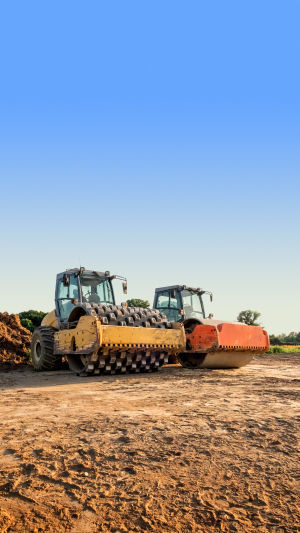Road rollers are used in all kinds of compaction operations by the gravity of the machinery itself, which causes permanent deformation and compaction of the layer being rolled.
There are two types of road roller: steel-wheeled and tyre-based.
A road roller, also known as a compactor, is a piece of equipment used for road construction.
It is widely used in the compaction of fill for high-grade highways, railways, airport runways, dams, stadiums and other large projects, and can compact sandy, semi-cohesive and cohesive soils, road base stabilisation soils and asphalt concrete pavement layers.
General compaction includes initial, recompaction and final compaction.
The final compaction is to remove the marks of the roller and to keep the pavement level, it cannot be omitted in general and is done with a steel wheel roller.
If the initial compaction can meet the density requirements, there is no need for recompaction, but all three steps are generally maintained.
Initial compaction is generally carried out with steel wheel rollers, but the phenomenon of nudging occurs, i.e. the mix on the front side of the drum is moved laterally under pressure and cracks may be produced after compaction.
The rubber wheel is also used for the initial compaction, but because the temperature is higher during the initial compaction, the mixture tends to adhere to the tyres and the traces left behind are not easily removed, so there are more opportunities for the rubber wheel to carry out the recompaction.
The advantages of the rubber wheel are mainly twofold.
1. Rubber wheel compaction is a kneading type of compaction, which is effective and can remove the small cracks produced by steel wheel compaction.
2. The rubber wheel compaction will make the mastic formed by asphalt, mineral powder and fine aggregate in the mix float upwards, making the upper surface more compact and waterproof.
There are also techniques when using the roller.
1. Whether uphill or downhill, the layer underneath the asphalt mix must be clean and dry, and must be sprayed with a bitumen bonding layer to avoid the mix slipping when rolling.
2. When rolling uphill, the roller must start, stop and accelerate smoothly to avoid excessive high or low speeds.
3. When rolling downhill on a steep slope, use a light roller for pre-compaction and then a heavy roller or vibratory roller for compaction.
4. Avoid sudden speed changes and braking when rolling.
5. The driving wheels of the roller should be at the rear of the roller, whether rolling uphill or downhill.
This has the following advantages: when going uphill, the rear driving wheel can withstand the ramp and the driving force provided by the machine itself, while the front wheel compares the road initially to withstand the larger shear force generated by the driving wheel.
When going downhill, the impact generated by the weight of the roller is offset by the braking of the driving wheel, and only the mixture after being rolled by the front wheel has the ability to support the shear force generated by the rear driving wheel.





